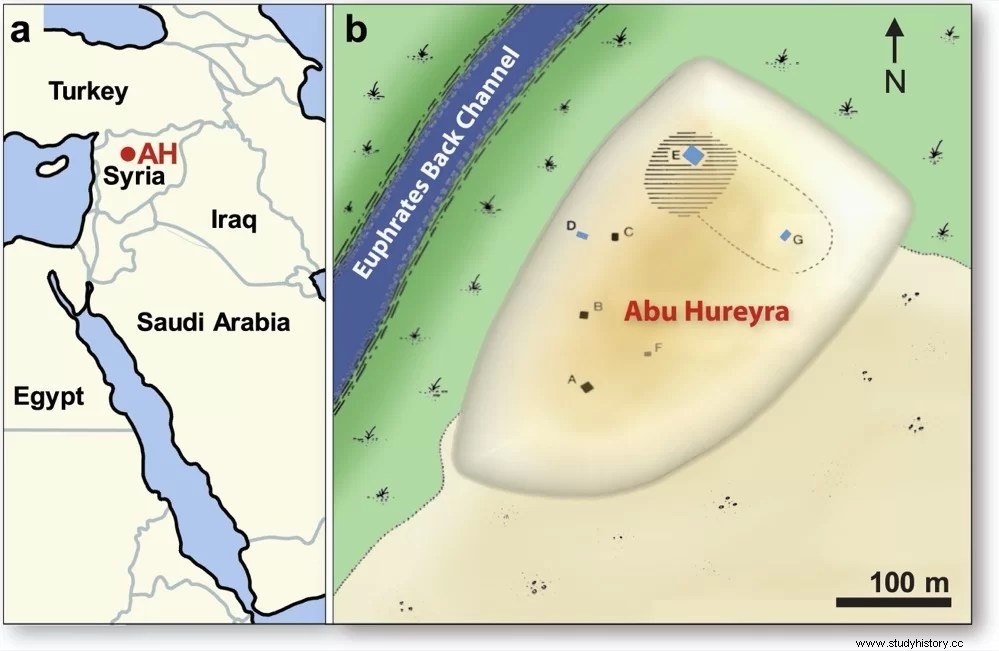Previously we talked here about Abu Hureyra, a site now submerged under the waters of a dam in Syria, where evidence of the transformation of humans from hunter-gatherers to farmers has been found. We said then that the oldest settlement dated from the Epipaleolithic (about 13,500 years ago) and about 1,300 years later, with the beginning of the Younger Dryas period (the period of climatic cooling at the end of the Pleistocene, between 12,700 and 11,500 years ago, which could be caused by the impact of the Clovis comet in North America), most of the population left the place, only a few families remained. They had to manage to survive drought and cold and developed the domestication of plant species, intentional planting and selection of strains. Then, when the climate became milder around 9500 B.C., the village grew again, to several thousand people, many spreading throughout the Middle East bringing this new biotechnology with them.
Now an article published by the University of California Santa Barbara reveals that among the remains of cereals, construction materials and animal bones, molten glass was also found in Abu Hureyra. Fragments whose characteristics suggest that it was formed at extremely high temperatures - much higher than what humans could reach at the time - or that could be attributed to fire, lightning or volcanism.
According to James Kennett, professor emeritus of geology at UC Santa Barbara, such temperatures would completely melt a car in less than a minute, such intensity could only have been the result of an extremely violent, high-energy, high-speed phenomenon, something on the order of a cosmic impact .

Based on materials collected before the site was flooded, Kennett and his colleagues argue that Abu Hureyra is the first site to document the direct effects of a fragmented comet impact on a human settlement. These fragments are all part of the same comet that probably crashed into Earth and exploded in the atmosphere at the end of the Pleistocene according to Kennedy. This impact contributed to the extinction of most large animals, including mammoths and American horses and camels; to the disappearance of the North American Clovis culture; and the abrupt onset of the Younger Dryas cooling episode.
The team's findings are highlighted in a paper published in the journal Nature Scientific Reports.
Our new discoveries represent much more powerful evidence for very high temperatures that could only be associated with a cosmic impact said Kennett, who with his colleagues first reported evidence of such an event in the region in 2012.
Abu Hureyra is located in the easternmost sector of what is known as the Younger Dryas scatter field, which encompasses some 30 other sites in the Americas, Europe and parts of the Middle East. At these sites, there is evidence of massive burning, including a widespread carbon-rich layer containing millions of nanodiamonds, high concentrations of platinum, and tiny metallic spherules formed at very high temperatures. The Younger Dryas impact hypothesis has gained more traction in recent years due to many new discoveries, including a very young impact crater beneath the Greenland Ice Sheet's Hiawatha Glacier, and high-temperature molten glass and other such evidence. at an archaeological site in Pilauco, in southern Chile.
The village of Abu Hureyra would have been abruptly destroyed Kennedy said. The glass was analyzed for its geochemical composition, shape, structure, formation temperature, magnetic characteristics, and water content. Analysis results showed that it formed at very high temperatures and included ores rich in chromium, iron, nickel, sulfides, titanium, and even platinum- and iridium-rich cast iron, all of which formed at temperatures above 2,200 degrees Celsius.

Critical materials are extremely rare under normal temperatures, but are commonly found during impact events Kennedy said. According to the study, the molten glass was formed from the near-instantaneous melting and vaporization of regional biomass, soils, and floodplain deposits, followed by instantaneous cooling . Also, because the materials found are consistent with those found in the Younger Dryas layers at other sites around the world, they are likely the result of a fragmented comet, as opposed to impacts caused by individual comets or asteroids.
A single large asteroid impact would not have caused materials as scattered as those discovered at Abu Hureyra according to Kennedy. It is proposed that the largest clumps of cometary debris are capable of causing thousands of airbursts within minutes across an entire hemisphere of the Earth. The YDB hypothesis proposed this mechanism to account for widely dispersed coeval materials over more than 14,000 km of the northern and southern hemispheres. Our Abu Hureyra discoveries strongly support a large impact event for such a fragmented comet .
